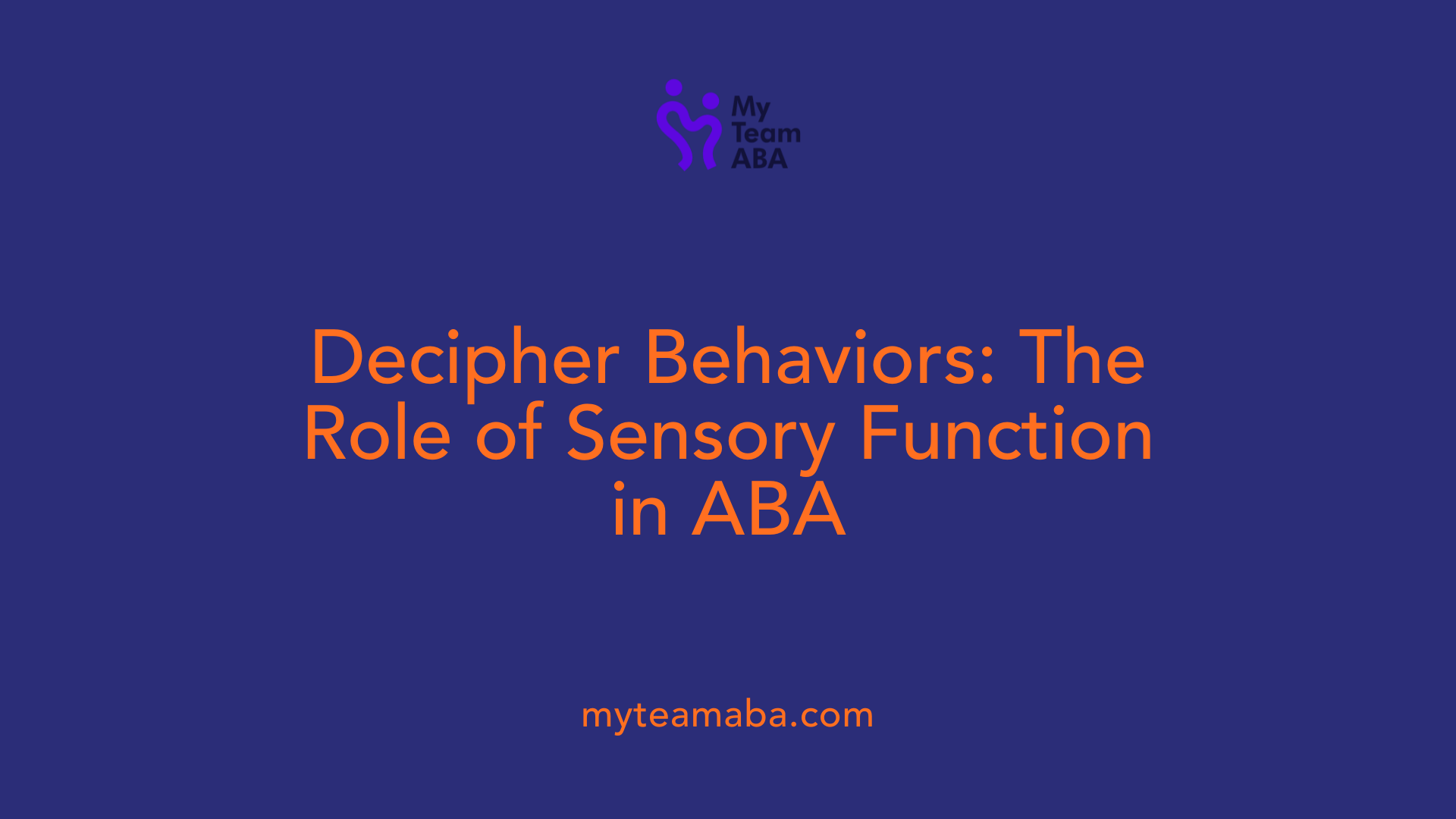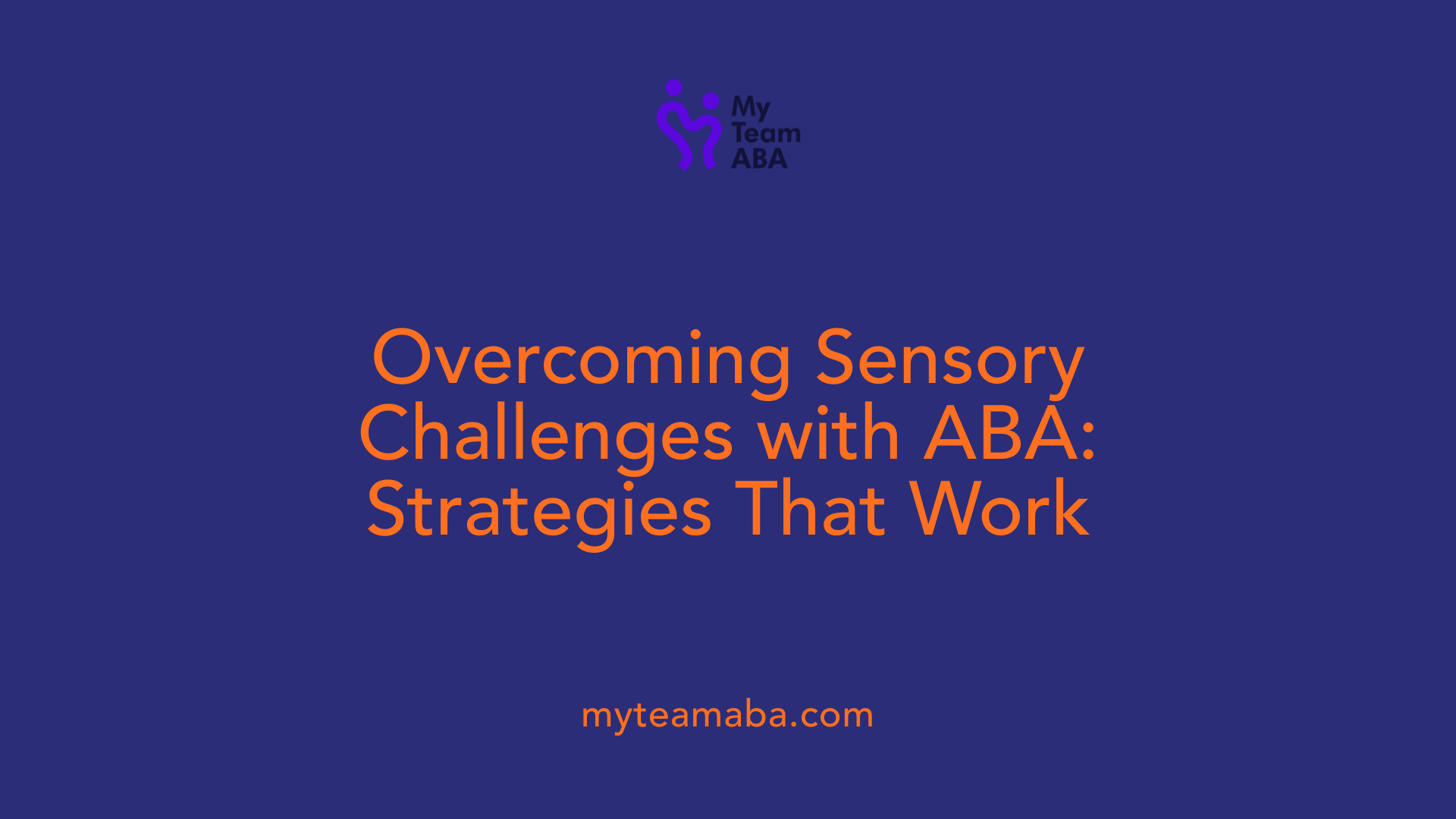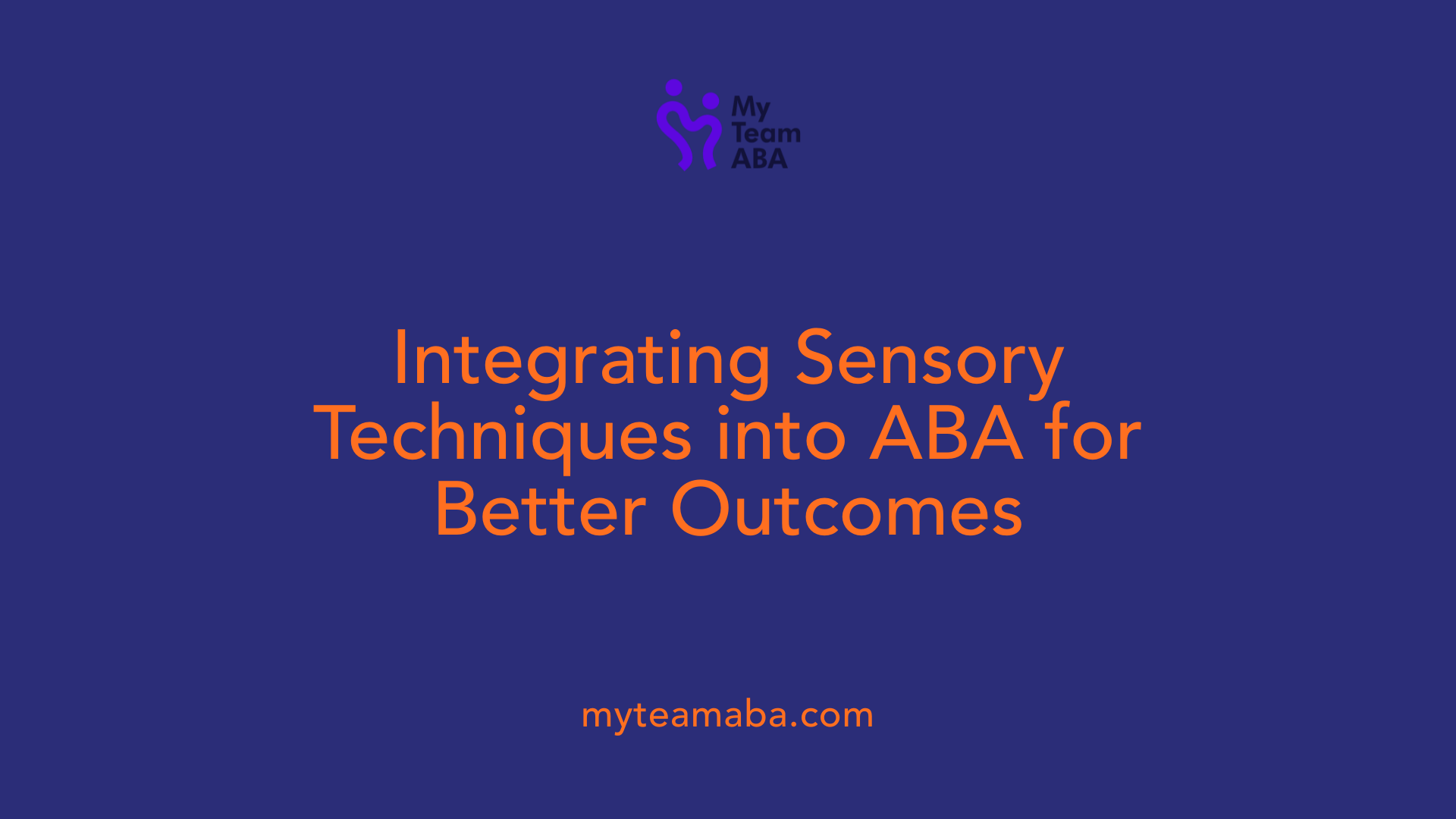How ABA therapy supports children with sensory needs
August 1, 2025
Enhancing Sensory Processing Through Applied Behavior Analysis

Understanding the Intersection of ABA and Sensory Needs in Children
Children with sensory sensitivities often face unique challenges that impact their daily lives, behaviors, and emotional well-being. Applied Behavior Analysis (ABA) has emerged as a promising approach to support these children by systematically addressing sensory-driven behaviors and promoting adaptive responses. This article explores how ABA therapy supports children with sensory needs, delving into specific techniques, their application, and the potential for integration with sensory-focused interventions.
The Sensory Function in ABA: Deciphering Behavior

What is the sensory function in ABA?
In Applied Behavior Analysis (ABA), the sensory function refers to behaviors that are maintained by an individual's need for sensory stimulation. This means that some actions are driven by a desire to experience certain sensations, either to seek out pleasant stimuli or to alleviate uncomfortable sensory experiences.
Children with sensory sensitivities might engage in behaviors like jumping, hand-flapping, rocking, or spinning. These behaviors provide sensory input that helps regulate their nervous system and make them feel more comfortable in their environment.
Understanding the sensory function is crucial because it helps caregivers and therapists identify why a child is engaging in specific behaviors. Instead of simply removing problematic actions, they can develop targeted strategies to meet the child's sensory needs.
Sensory behaviors are one of the four main functions of behavior recognized in ABA, alongside seeking attention, escaping a demand, and obtaining tangibles. Recognizing this allows practitioners to craft interventions that provide appropriate sensory reinforcement, reducing maladaptive behaviors and encouraging positive, functional actions.
By systematically analyzing and addressing the sensory function, ABA therapy aims to help children better self-regulate, develop adaptive coping skills, and engage more comfortably with their surroundings.
Addressing Sensory Challenges with Targeted ABA Strategies

Does ABA help with sensory issues?
Yes, ABA therapy can significantly assist children with sensory sensitivities. It focuses on understanding and modifying behaviors related to sensory stimuli through a variety of targeted interventions. For example, ABA incorporates sensory breaks—scheduled periods where children engage in calming activities—to help regulate their responses to overwhelming stimuli.
ABA therapists also use desensitization protocols, which involve gradually exposing children to sensory inputs in a controlled and supportive manner. This step-by-step approach helps children build tolerance and reduces maladaptive behaviors like sensory avoidance or meltdowns.
Reinforcement strategies are central to ABA's success. Children are rewarded for using coping mechanisms such as asking for a break or self-calming behaviors. These positive reinforcements encourage adaptive responses and help children develop emotional regulation skills.
Behavioral modifications are tailored to each child's sensory profile. For instance, creating sensory-friendly environments—using tools like fidget toys or calming sensory bottles—can decrease sensory overload.
In addition to direct interventions, ABA can be integrated with sensory integration techniques, known as 'sensory integration ABA.' This combined approach involves engaging activities like tactile, proprioceptive, vestibular, and auditory exercises. Such therapies are designed to improve how children process sensory information, making everyday environments less overwhelming.
Overall, ABA provides a structured framework that emphasizes measurable goals and individualized strategies. Data collection helps therapists and parents track progress and adjust techniques accordingly. The combination of reinforcement, systematic desensitization, and environmental modifications equips children with tools to better manage sensory sensitivities, leading to more positive participation in daily life.
Incorporating Sensory Integration Techniques into ABA

How can ABA therapy support children with sensory needs?
ABA therapy plays a crucial role in helping children with sensory challenges develop better responses to their environment. It utilizes tools like functional behavior assessments to pinpoint specific sensory triggers, allowing therapists to craft tailored interventions. Through reinforcement strategies such as positive reinforcement—rewarding desirable behaviors—and differential reinforcement—which encourages alternative coping behaviors—children learn to respond more adaptively to sensory stimuli.
A significant aspect of ABA for sensory needs involves the integration of sensory-based techniques. These include sensory breaks, which provide children with structured opportunities to pause and self-regulate; desensitization protocols that gradually expose children to sensory inputs to build tolerance; and graduated exposure to different sensory stimuli, helping children manage sensitivities over time.
ABA also incorporates structured activities like play-based tasks, visual supports, and auditory tools, all designed to foster emotional regulation and reinforce positive behaviors. Customized sensory diets are often incorporated within ABA plans, involving activities such as heavy work, calming sensory experiences, and the use of fidget toys, which help children stay regulated throughout their day.
Methods of combining therapies
To maximize outcomes, ABA is frequently combined with sensory integration approaches, often through sensory integration ABA. This hybrid method blends behavioral strategies with occupational therapy techniques centered on sensory processing.
Sensory integration therapy (SIT) is typically a play-based, clinic-oriented approach focusing on improving a child's ability to process sensory information. Activities in SIT include tactile experiences, proprioceptive exercises (which involve body awareness), vestibular inputs (like swinging or rocking), and auditory activities. When implemented properly, SIT helps children develop sensory tolerance, body awareness, and better sensory–motor integration.
The combination of ABA and sensory integration therapy offers a comprehensive framework. ABA addresses behavioral responses and emotional regulation, while sensory integration techniques aim to improve sensory processing, making it easier for children to tolerate daily sensory stimuli.
How do methods of combining therapies enhance outcomes?
Merging ABA with sensory integration techniques provides a more holistic support system. ABA’s structured reinforcement and behavior modification create an environment where children are motivated to practice new responses while sensory integration activities directly target their processing challenges.
For example, within an ABA session, a child might receive reinforcement for using coping strategies like asking for a break, while concurrently engaging in sensory activities that gradually increase their tolerance to sensory stimuli. Such combined approaches facilitate the development of adaptive behaviors, emotional resilience, and the ability to participate more fully in daily life.
| Therapy Component | Method | Focus | Benefits | Additional Details |
|---|---|---|---|---|
| ABA Techniques | Reinforcement, desensitization | Behavior modification | Reduce maladaptive responses | Reinforces positive responses to sensory input |
| Sensory Integration | Tactile, proprioceptive, vestibular activities | Sensory processing | Improve tolerance and processing | Fun, engaging activities tailored to the child's needs |
| Combined Strategies | Sensory diets with ABA routines | Self-regulation and behavior | Better emotional regulation | Structured environment with personalized activities |
Through these integrative methods, therapies become more effective in helping children manage sensory sensitivities and thrive in their environments.
Sensory Integration Activities in Therapy Settings
What are some examples of sensory stimulus interventions used in ABA?
ABA therapy employs various sensory interventions to help children manage their sensory sensitivities and reduce maladaptive behaviors. These activities are tailored to each child's unique sensory profile and aim to promote regulation and comfort.
One common approach involves providing preferred sensory stimuli—such as tactile, visual, or auditory inputs—to reinforce positive behaviors. For example, using textured toys during a reinforcement session can make learning more engaging and help the child associate calming sensory experiences with desired behaviors.
Sensory breaks are another integral part of therapy. These are structured periods where children engage in activities designed to meet their individual sensory needs, like swinging, squeezing a stress ball, or listening to calming sounds. These breaks help children reset and return to tasks with better focus.
Specific exercises targeting different sensory systems include:
- Tactile activities: Playing with different textured materials like sand, rice, or slime.
- Proprioceptive exercises: Heavy work activities such as pushing or pulling objects, carrying weighted bags, or animal walks.
- Vestibular exercises: Swinging, spinning, or balance activities that stimulate the inner ear and help balance.
- Auditory activities: Listening to calming music, noise-canceling headphones, or using sound-based sensory toys.
To improve tolerance to sensory stimuli, therapists might use gradual desensitization—introducing stimuli slowly over time to prevent overwhelming the child. Sensory diets—personalized plans involving various sensory activities—are also designed to provide calming or alerting input based on the child's needs.
Environmental modifications are also helpful; for example, adjusting lighting levels or reducing visual clutter can minimize sensory overload at home or in therapy settings. Teaching children self-advocacy skills, such as asking for a break or communicating sensory discomfort, is crucial for fostering independence.
Collecting data throughout these activities allows therapists and parents to track progress and adjust strategies as needed. This systematic approach ensures that children develop better sensory processing skills and behavioral responses, enabling them to participate more fully in daily activities.
Comparing ABA and Sensory Integration Therapy
How does ABA therapy compare to sensory integration therapy?
Applied Behavior Analysis (ABA) therapy and sensory integration therapy are two distinct approaches often used to support children with sensory needs, especially those with autism spectrum disorder (ASD). ABA primarily focuses on understanding and modifying specific behaviors through reinforcement techniques. Its goal is to replace maladaptive behaviors with more functional, positive responses, helping children develop social, communication, and daily living skills.
In contrast, sensory integration therapy emphasizes improving the brain's ability to process and organize sensory information from the environment and the body. Using play-based activities such as swinging, deep pressure, tactile exercises, and vestibular activities, this therapy aims to help children become more self-regulated and responsive to sensory stimuli.
While ABA is backed by extensive research and evidence-based methodologies, sensory integration therapy's science support is less conclusive. Many studies report anecdotal benefits, but rigorous scientific validation remains limited. That said, both therapies can work together effectively. ABA can teach children coping behaviors and emotional regulation skills, while sensory integration activities can address underlying sensory processing difficulties.
Ultimately, the best approach hinges on each child's individual needs. Many treatment plans combine elements of both therapies to provide a comprehensive support system. For example, a child might learn to ask for a sensory break through ABA, while simultaneously engaging in sensory activities to improve tolerance and processing.
Below is a simplified comparison of these approaches:
| Aspect | ABA Therapy | Sensory Integration Therapy | Additional Details |
|---|---|---|---|
| Focus | Behavior modification | Sensory processing | ABA targets observable behaviors; sensory integration touches on neural responses |
| Evidence base | Strong, well-established | Limited, anecdotal | ABA is considered an evidence-based practice; SIT needs more research |
| Techniques | Reinforcement, prompting, shaping | Play-based activities, swinging, tactile exercises | Methods align with their core focuses |
| Goals | Reduce maladaptive behaviors, develop skills | Improve sensory processing, self-regulation | Both aim to support overall functioning |
| Complementary use | Yes | Yes | Combining strategies can address both behavioral and sensory needs effectively |
In sum, when selecting therapies, professionals often recommend integrating behavioral strategies with sensory processing interventions for a well-rounded approach that caters to all aspects of a child's development.
Therapeutic Outcomes and Benefits for Sensory Children
Can therapy effectively help manage sensory processing challenges?
Yes, therapy can significantly assist children facing sensory processing challenges. Occupational therapy, especially sensory integration therapy (SIT), is frequently employed to help children better handle sensory stimuli. These interventions focus on gradually improving a child's tolerance to sensory input, reducing feelings of overwhelm, and developing strategies to cope effectively.
In sensory integration therapy, children participate in play-based, structured activities designed to enhance sensory processing and motor skills. For example, activities like tactile play, proprioceptive exercises such as heavy work, vestibular activities like swinging, and auditory exercises are integrated within therapy sessions.
Therapists often incorporate tools like sensory diets—personalized schedules of activities—fostering regulation throughout the day. These may include sensory breaks, calming sensory activities, or fidget tools, helping children self-regulate and participate more fully in daily routines.
Beyond sensory processing, ABA strategies support behavioral and emotional regulation. Through reinforcement, desensitization protocols, and specific coping techniques such as asking for a break or using visual cues, children learn to manage their responses to sensory stimuli. Data collection during therapy sessions enables caregivers and therapists to tailor interventions and track progress over time.
While sensory processing disorder itself currently lacks a cure, effective therapy can profoundly enhance a child's ability to function and thrive. Early assessment and personalized, consistent intervention are critical for optimal outcomes. Many children benefit from a combined approach, integrating sensory integration techniques with behavior modification strategies to address both sensory sensitivities and behavioral responses.
What improvements can therapy bring to sensory children?
Therapeutic interventions aim for multiple positive outcomes:
- Reduced maladaptive responses to sensory stimuli
- Better emotional regulation and resilience
- Increased tolerance to challenging sensory inputs
- Enhanced self-advocacy skills, including communication of sensory needs
- Improved participation in daily activities and social interactions
By systematically working through exposure and skill-building, therapy helps children develop confidence and independence. These improvements not only support immediate functioning but also foster long-term well-being.
Final notes on therapy benefits
Research shows that combining sensory integration techniques with behavioral strategies can lead to meaningful progress. While more studies are needed to deepen our understanding, current evidence indicates that tailored interventions offer substantial benefits.
Parents and caregivers play a vital role by implementing sensory diets at home, creating sensory-friendly environments, and collaborating with therapy providers to ensure consistency and progress tracking.
In summary, therapy—especially when personalized—serves as a powerful tool to help children with sensory needs develop essential skills, cope better with their environment, and enjoy an improved quality of life.
Supporting Children with Sensory Needs Through a Holistic Approach
How does the integration of ABA, sensory therapy, and environmental modifications support children with sensory differences?
ABA therapy plays a vital role in supporting children with sensory needs by systematically understanding and modifying behaviors related to sensory stimuli. Therapists break down sensory behaviors into measurable components and use reinforcement strategies—such as rewarding coping techniques or alternative responses—to promote positive behavior changes.
In addition to ABA, sensory integration techniques are incorporated in specialized forms like
Data Monitoring and Personalized Interventions in ABA
How does data collection during ABA therapy help monitor progress and inform adjustments?
In ABA therapy, continuous data collection is essential for understanding a child’s responses to various sensory stimuli. Therapists record specific behaviors, triggers, and reaction patterns systematically during sessions. This detailed data provides a clear picture of what strategies are working and which ones may need refinement.
By tracking progress over time, therapists can identify trends and measure improvements in how children handle sensory input. For example, if a child begins to tolerate more tactile stimuli or requests fewer sensory breaks, these changes can be documented to showcase progress.
More importantly, this data allows for real-time adjustments. If a particular intervention does not yield the desired behavior change, therapists can modify their approach promptly. This might involve tweaking reinforcement strategies, adjusting the intensity of desensitization protocols, or introducing new coping mechanisms.
The cumulative insights gained from systematically analyzing therapy data lead to more personalized plans. As each child's sensory profile and responses are unique, data-driven adjustments ensure that interventions are tailored specifically to their evolving needs.
This process not only enhances the effectiveness of therapy but also helps build trust with children. When children see consistent, relevant changes based on their responses, they are more likely to engage actively in their therapy sessions.
Why is creating individualized plans critical in ABA therapy for sensory issues?
Each child with sensory needs experiences sensitivities and tolerances differently. A one-size-fits-all approach often falls short in addressing these individual differences.
Developing personalized strategies involves detailed assessment of the child's sensory profile, triggers, preferences, and behavioral responses. This personalized plan might include specific sensory diets, tailored coping skills like deep breathing or visual supports, and environmental modifications suited to the child's unique sensitivities.
Individual plans incorporate specific goals, such as increasing tolerance to certain stimuli or reducing maladaptive sensory behaviors. They also include practical tools like sensory breaks, fidget toys, or calming activities that suit the child's interests and needs.
By customizing interventions, therapists can create a supportive environment that promotes emotional regulation and adaptive behaviors. These tailored approaches ensure that children are not overwhelmed but are gradually desensitized in a safe, controlled manner.
Furthermore, personalized plans foster better engagement and motivation. When children experience success through customized interventions, their confidence and cooperation tend to improve.
Overview of the process and tools used in data collection and personalized therapy
Data collection in ABA involves tools like checklists, digital apps, and behavior tracking charts to record specific actions and reactions during sessions.
Personalized interventions often include:
| Tool/Strategy | Purpose | Example |
|---|---|---|
| Sensory Diet | Provides tailored activities to regulate sensory input | Heavy work, calming sensory bottles |
| Fidget Toys and Tools | Encourage self-regulation in sensory environments | Chew toys, textured fabrics |
| Environmental Modifications | Adjusting surroundings to reduce overwhelm | Soft lighting, noise reduction devices |
| Coping Strategies | Teach children self-regulation and communication skills | Asking for a break, deep breathing |
| Routine and Visual Supports | Help with predictability and reduce anxiety | Visual schedules, timers |
This structured approach, combining data-driven insights with personalized tools, aims to help children with sensory needs develop better regulation skills and thrive in their daily environments.
The Path Forward in Supporting Sensory-Impacted Children
ABA therapy offers a structured, evidence-based framework for supporting children with sensory needs. When tailored and integrated with sensory-focused strategies, it can significantly improve behavioral responses, emotional regulation, and overall quality of life. As research advances and understanding deepens, combining ABA with sensory integration techniques and environmental modifications is likely to become the gold standard for comprehensive care, offering hope for more adaptive, resilient, and well-regulated children.
References
- All You Need to Know About ABA and Sensory Integration Therapy
- Can ABA Help with Sensory Issues? Discover the Benefits
- 7 Key Benefits of ABA Therapy for Children
- ABA Therapy and Sensory Issues: Walking the Journey Together
- Introduction - Sensory integration therapy for children with autism ...
- Introduction - Sensory integration therapy for children with autism ...
- All You Need to Know About ABA and Sensory Integration Therapy
- Can ABA Help with Sensory Issues? Discover the Benefits
- ABA Therapy and Sensory Issues: Walking the Journey Together
